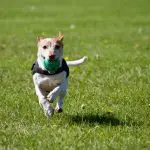Norwich Terrier
Description:
The Norwich Terrier and the Norfolk Terrier are closely related and in fact were once classified as two varieties of the same breed. After 1964 the erect or prick-eared variety was classified (in England) as the Norwich Terrier and the folded or drop-eared variety was called the Norfolk Terrier. The Norwich has a broad and slightly rounded skull, with expressive eyes and, of course small erect ears. The body is small and compact with short sturdy legs. The Norwich’s coat is a hard and close-lying wire haired coat. This breed’s coat is shorter on the head and ears and longer on the neck, shoulders, moustache, beard and eyebrows. These terriers come in a range of colors – including red, yellow or wheaten, black and brown or grey. Both these breeds of terriers are small and only stand about 10 inches tall at shoulder height and weigh from 11 to 15 pounds. The Norwich is a member of the
American Kennel Club (AKC) Terrier Group.
History:
As previously mentioned, the Norwich and Norfolk Terriers were once classified as the same breed up until 1964 in England. In the U.S. the two separate breeds were recognized in 1979. The ancestry of these terriers is unclear but they probably include Border, Cairn and Irish terrier. They were bred for hunting vermin and were later used by fox hunters to chase foxes from their dens when they went to ground. The Norwich terrier was ranked 99th out of 154 dog breeds in 2004 AKC registrations.
Temperament:
The Norwich is a happy and fearless little ‘teddy bear’ of a dog. This terrier is one of the smallest of the terrier breeds abut it has one of the largest personalities. The Norwich is sociable, lively, friendly, playful and impudent. Some owners claim the Norfolk has a sweeter disposition than the Norwich and others argue the opposite position. Both these terrier breeds seem to get along well with children and make good family dogs. Because these terriers are so small, toddlers and small children should be supervised to stop them from being too rough with the dog. Norwich’s have to be part of the family and participate in all activities. They love to go on long walks and automobile trips with the family. Norwich’s, unlike most terriers, love obedience training and can be trained quite easily. These terriers are somewhat reserved with strangers and have to be socialized well to stop them from chasing cats. The Norwich is an alert dog with good
hearing which makes and excellent watchdog. These terriers are quite suitable for novice or first-time dog owners.
Exercise:
These terriers are fairly energetic and love to go on walks or play ball with their families. They tolerate all types of weather. The Norwich love to dig holes in your backyard so you should be on guard for this breed-related trait. Norwich’s do well in apartments as long as they get outside for exercise.
Grooming:
The Norwich should be brushed and combed once or twice per week – paying special attention to the beard and moustache which get dirty more often. The wiry coat doesn’t shed much and needs to have the dead and excess hair hand plucked about twice per year. Excess hair should be trimmed between the paw pads. This low-shedding breed is sometimes called ‘hypoallergenic’ and if it is properly groomed should be good for people with allergies.
Health Considerations:
Norwich Terriers have a fairly long like expectancy and should live for 12 to 14 years. The Norwich is not prone to many serious inherited health concerns although cataracts are fairly common. On occasion other eye diseases such as glaucoma and corneal dystrophy are present. Cramps, epilepsy, luxating patella and respiratory problems have also been seen in some breeding lines. Buyers of Norwich puppies should ask to see the parents recent CERF (Canine Eye Registry Foundation) results.
Article type: xdogbreed


